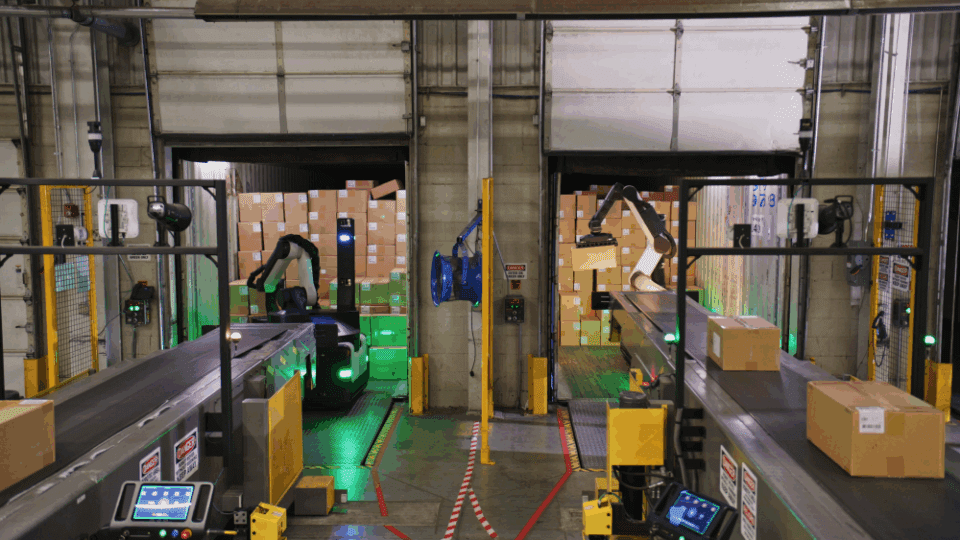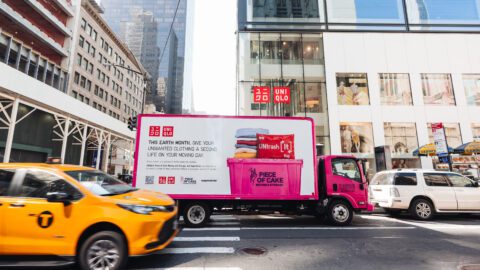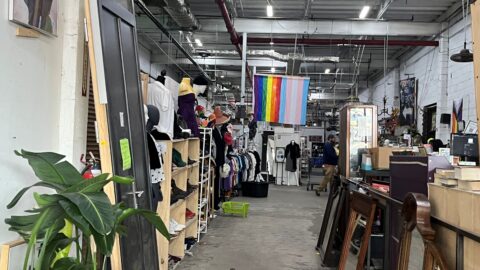Among the many tough jobs in a distribution center, unloading boxes from a trailer is one of the toughest. “There’s a higher risk of injury than in other parts of the DC, and unloading was a job that very few people liked to do,” said Kevin Kuntz, SVP of Global Logistics and Operations at Gap. “It’s hot in a trailer in the summertime, it’s cold in the wintertime and it’s heavy all the time.”
Sounds like a job for a robot, and that’s what Gap has deployed — the Stretch robot from Boston Dynamics. These mobile robots are equipped with computer vision and can maneuver in any direction, navigate around obstacles and traverse ramps, and their footprint is the same as a standard shipping pallet, meaning that anywhere a pallet can go, Stretch can follow.
The robot — which is equipped with capabilities including label detection and automatic reorientation for downstream scanning — uses an adaptive vacuum-based gripper to handle a wide range of package shapes and surfaces. (Here’s a video of Stretch in operation.) Stretch also can perform multi-case picking, i.e., handling more than one case at a time.
The productivity gains already have been impressive. The robot enables Gap to process 10,000 cases per day, which would normally take 12 to 15 people to accomplish. Now, one worker can supervise the operations of two Stretch robots, which are “really helpful to run our inbound operations seven days a week with minimal staffing,” said Kuntz in an interview with Retail TouchPoints.
Advertisement
After beta testing the technology in its Fishkill, N.Y. facility, Gap conducted a successful year-long pilot in Tennessee. “Now we’ve rolled it out to three other sites across Ohio, Texas and California,” said Kuntz. “We’re really excited about the results that we’re seeing and plan to expand further in the future, especially as we start to test new capabilities besides unloading, such as using Stretch for palletization [stacking cases on pallets].”
Using Robots to Handle Labor-Intensive, Injury-Prone Tasks
The nature of modern warehouse operations demands technology that can perform a range of tasks, particularly when the facility is fulfilling online sales, which “usually means way more individual orders and a flood of boxes coming in all shapes and sizes,” said Alex Perkins, Senior Technical Director at Boston Dynamics and Chief Roboticist for Stretch in an interview with Retail TouchPoints. “In fact, online fulfillment often demands about 5X more labor than restocking retail stores. That’s where Stretch really shines. Operational agility is critical as warehouses face increasing variability in tasks, box sizes and weights and environmental conditions.
“This is one of the most labor-intensive and injury-prone tasks in distribution centers, so the technology reduces the need for manual labor in the inbound department, which is what we’ve seen improve greatly at Gap facilities,” Perkins added.
Kuntz agreed that the higher risk of injury for humans performing these tasks makes the use of robots a plus for Gap, and also fits in with the retailer’s strategic roadmap “to make our business more digitally enabled, but human centered.
“If you were to go back in time [prior to deploying Stretch] you would see a combination of people unloading and palletizing product, maybe three or four doors at a time,” Kuntz added. “Now, we can have two Stretch robots running with one person supervising at a safe distance to make sure that things are working well.”
Kuntz also appreciates that the robots don’t need to be tightly integrated with the various inventory and warehouse management systems Gap uses in its DCs. “It’s literally wirelessly tethered to one piece of conveyor that extends in and out of a trailer,” he said. “We didn’t need any tech support on the Gap Inc. side. It was easy to deploy; it’s easy to maintain.”
The ‘Cool Factor’ to Managing Robots
While many people resist using new technology when it’s introduced (the devil you know and all that), Kuntz reported that employees are excited to work with the Stretch robots. “One of the intangible benefits is the cool factor,” he said. “You bring in a solution that’s automating [the unloading process], and you’re training your existing staff to drive a robot, get it started, supervise it through the shift, and then they can run two robots. It’s something the teams are excited about now, and they brag to friends and family [that] they’re operating cutting-edge tech at work instead of manually moving boxes. Not all warehouse workers are doing that today, but our teams are learning new skills.”
The Stretch robot’s development actually was spurred by Boston Dynamics’ humanoid robot Atlas. The company put out a YouTube video featuring Atlas moving boxes between shelves and “after seeing the video, a large logistics company reached out to us about robots unloading trucks,” said Perkins. “We built Stretch with the purpose of solving a specific, yet very common logistics problem — unloading inbound shipments in a fast, reliable and safe way. But during design, we also were careful to consider other case-handling applications, including palletizing and order building.”
In addition to Gap, the Stretch robots, which were introduced commercially in 2022, have been deployed by retail and logistics companies including Otto Group, DHL, Maersk and H&M. Boston Dynamics continues to improve the technology “based on customer demands, from case mix to trailer configurations to throughput requirements; that’s why we created multi-case picking,” said Perkins.
While the Stretch robots are increasingly popular, they still have some catching up to do when it comes to Boston Dynamics’ quadruped robot, Spot. These canine-like robots can climb stairs and traverse rough terrain and are small enough to access hazardous or hard-to-reach locations. Spot supports remote operation and autonomous sensing across a range of industries, with more than 1,500 of the robots already “out in the world taking on a number of different tasks, from collecting equipment data in industrial facilities to creating digital twins on construction sites to helping first responders safely assess potentially hazardous situations,” said Perkins.















